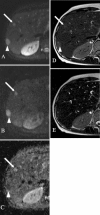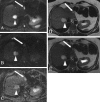Characterization of focal liver lesions using quantitative techniques: comparison of apparent diffusion coefficient values and T2 relaxation times
- PMID: 22699872
- PMCID: PMC3472073
- DOI: 10.1007/s00330-012-2519-x
Characterization of focal liver lesions using quantitative techniques: comparison of apparent diffusion coefficient values and T2 relaxation times
Abstract
Objectives: To compare the efficacy of two quantitative methods for discrimination between benign and malignant focal liver lesions (FLLs): apparent diffusion coefficient (ADC) values and T2 relaxation times.
Methods: Seventy-three patients with 215 confirmed FLLs (115 benign, 100 malignant) underwent 1.5-T MRI with respiratory-triggered single-shot SE DWI (b = 50, 400, 800) and dual-echo T2TSE (TR = 3,000 ms; TE1 = 84 ms; TE2 = 228 ms). ADC values and T2 relaxation times of FLLs were calculated. Sensitivity, specificity and accuracy of both techniques in diagnosing malignancy were assessed.
Results: The mean ADC value of malignant tumours (1.07 × 10(-3) mm(2)/s) was significantly lower (P < 0.05) than that of benign lesions (1.86 × 10(-3) mm(2)/s ); however, with the use of the optimal cut-off value of 1.25 × 10(-3) mm(2)/s, 20 false positive (FP) and 20 false negative (FN) diagnoses of malignancy were noted, generating 79 % sensitivity, 82.6 % specificity and 80.9 % accuracy. The mean T2 relaxation time of malignant tumours (64.4 ms) was significantly lower (P < 0.05) than that of benign lesions (476.1 ms). At the threshold of 107 ms 22 FP and 1 FN diagnoses were noted; the sensitivity was 99 %, specificity 80.9 % and accuracy 89.3 %.
Conclusions: Quantitative analysis of T2 relaxation times yielded significantly higher sensitivity and accuracy in diagnosing malignant liver tumour than ADC values.
Key points: • Diffusion-weighted magnetic resonance imaging is increasingly used for liver lesions. • But ADC values demonstrated only moderate accuracy for differentiation of liver lesions. • T2 relaxation times yielded higher accuracy in diagnosing malignant liver tumours. • Both ADC and T2 values overlapped between focal nodular hyperplasia and malignant lesions. • Nevertheless T2 liver mapping could be valuable for evaluating focal liver lesions.
Figures






References
-
- Xu PJ, Yan FH, Wang JH, Lin J, Ji Y. Added value of breathhold diffusion-weighted MRI in detection of small hepatocellular carcinoma lesions compared with dynamic contrast-enhanced MRI alone using receiver operating characteristic curve analysis. J Magn Reson Imaging. 2009;29:341–349. doi: 10.1002/jmri.21650. - DOI - PubMed
-
- Hammerstingl R, Huppertz A, Breuer J, et al. European EOB-study group. Diagnostic efficacy of gadotrexid acid (Primovist)-enhanced MRI and spiral CT for a therapeutic strategy: comparison with intraoperative and histopathologic findings in focal liver lesions. Eur Radiol. 2010;18:457–467. doi: 10.1007/s00330-007-0716-9. - DOI - PubMed
Publication types
MeSH terms
LinkOut - more resources
Full Text Sources
Medical
Miscellaneous

